| Reviews & Columns |
|
Reviews DVD TV on DVD Blu-ray 4K UHD International DVDs In Theaters Reviews by Studio Video Games Features Collector Series DVDs Easter Egg Database Interviews DVD Talk Radio Feature Articles Columns Anime Talk DVD Savant Horror DVDs The M.O.D. Squad Art House HD Talk Silent DVD
|
DVD Talk Forum |
|
|
| Resources |
|
DVD Price Search Customer Service #'s RCE Info Links |
|
Columns
|
|
|
Batman: '89-'97 Anthology
Warner Bros. // PG-13 // March 10, 2009
List Price: $129.95 [Buy now and save at Amazon]
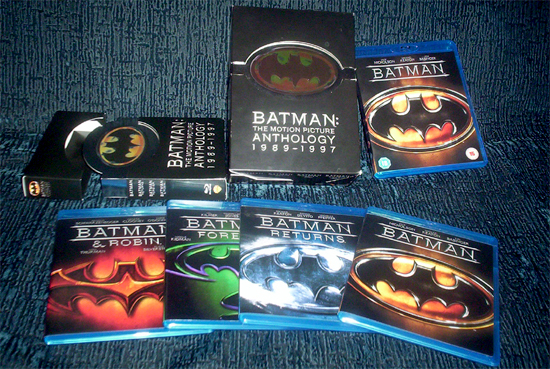
Though Batman began his long journey through media in the May 1939 issue of Detective Comics, # 27, Lewis Carrol first brought the character to life on screen in a series of stiff serials in 1943. From there, the millionaire-turned-vigilante has taken many shapes and forms -- ranging from'60s camp television with Adam West to the modern, reality bound intensity with Christopher Nolan's pictures, Batman Begins and The Dark Knight.
But from the late-'80s to the late-'90s, Warner Brothers built a small empire with Bob Kane's character that would pave way for the very definition of the summer blockbuster staple. Print media, television, anything that could announce that Batman was swooping back into the theaters lit up with tag-lines and teasers alike. And for good reason: with his adult thematic tones, tech-based intrigue not unlike James Bond, and his ability to fight crime without the aid of superpowers, he's an absurdly dynamic entity that poses no trouble in identifying with movie goers.
Batman -- Batman Returns -- Batman Forever -- Batman and Robin -- Blu-ray A/V Review
Batman (1989):  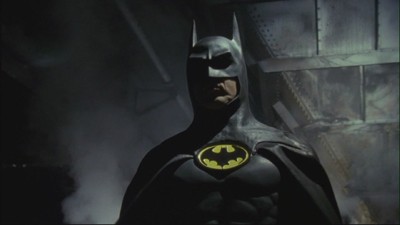 "Can somebody tell what kind of a world we live in where a man dressed up as a BAT gets all my press? This town needs an enema!" -- The Joker, Batman "Can somebody tell what kind of a world we live in where a man dressed up as a BAT gets all my press? This town needs an enema!" -- The Joker, Batman Though Tim Burton was riding the wave of his Beetlejuice success in 1988, he still had to push hard to sell his vision of Batman to Warner Brothers for his '89 debut of the character -- one marked by a dark tone heavily influenced by the '88 graphic novel "The Killing Joke", also a strong influence on Christopher Nolan's The Dark Knight. It took some force for the now-legendary gothic director to ensure that Batman was going to tap into a similar shadowy disposition that the character embodied at the time, a fight made even harder when he cast his comedy-based Beetlejuice star Michael Keaton instead of a more debonair Hollywood face. Though some feared a retread into the '60s "Blam-Kapow!" demeanor, they would soon have only modest reasons to protest. Batman digs more into the brooding illumination of character histories than a cohesive story, focusing heavily on billionaire Bruce Wayne's (Michael Keaton) oddly-driven manner and The Joker's (Jack Nicholson) acid-coated evolution ... or devolution, however you'd like to look at it. It takes the characters -- one a socially-awkward orphan with a unfathomable bankroll, the other a powerful yet second-rate mob boss named Jack Napier -- and allows them to churn and shift around the presence of a bizarre "man dressed up as a bat" that aims to purge Gotham of crime. Though the camera rarely leaves Wayne and Napier's sight, their development takes place under the eyes of curious Bat-hungry reporters Alexander Knox (Robert Wuhl) and Vicki Vale (Kim Basinger). Paired with the strong of Gotham TV and the newspapers in the film, they give the low-key narrative rhythm an almost reporter-style exposition as we learn how Jack grasps a hold of his new persona as the Joker to try and tear down the city of Gotham -- and witness how Wayne copes with his grief-stricken presence as the Caped Crusader, the city's only hope against The Clown Prince. Burton reinforces this media-driven method, along with putting comic book lover's fears to rest, by capturing Batman in a uniquely fluid structure that feels more like panels in motion than a streaming narrative. Stopping the picture at any moment feels like an image you'd likely find in any of Jeff Loeb or Frank Miller's sketches, all accompanied by a script that emphasizes an episodic feel about both the scenes and dialogue. Surprisingly un-cinematic in ways, it's mesmerizing to behold as each segmented scene comes together into an almost literal interpretation of the "comic book film" -- and an inspired one at that -- that focuses on a blunt rhetoric that emphasizes the actors' abilities to soak into their legendary, well-drawn characters. Though this is a mild entry into Tim Burton's repertoire, let's remember that it's still constructed in a man's mind that likes to steer clear of the obvious. Michael Keaton as Batman epitomizes that effort. He gives Bruce Wayne a daffy sort of charm as the reserved billionaire, but it intermingles well with his duality by beefing up the unlikelihood of Wayne as Batman. Keaton tapped into Frank Miller's "The Dark Knight Returns" for motivation, and it shows through his portrayal of Bruce Wayne's burdened drive to hunt down the Joker. He's also a surprisingly good Batman, adding even more to his strongly-segmented personality with a strong poise and wide-jawed snarls that would become the aesthetic reference point for many years. 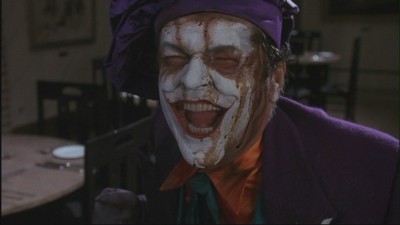 Jack Nicholson, on the other hand, does something just as unique with his presence as The Joker; he plays up the stiff mobster persona, and then carefully flips it like a mentally-unstable hourglass once he begins his transformation. He dominates the film by grabbing our attention to his bizarre, long-winded soliloquies and short-yet-voracious attention span, making the process of watching his grains of sand pour from sanity to delusion an enthralling experience. Nicholson seems like an odd choice for The Joker, and he is, but there's something about his melting-pot, aged riff of the character that remains strangely riveting from front to end. Jack Nicholson, on the other hand, does something just as unique with his presence as The Joker; he plays up the stiff mobster persona, and then carefully flips it like a mentally-unstable hourglass once he begins his transformation. He dominates the film by grabbing our attention to his bizarre, long-winded soliloquies and short-yet-voracious attention span, making the process of watching his grains of sand pour from sanity to delusion an enthralling experience. Nicholson seems like an odd choice for The Joker, and he is, but there's something about his melting-pot, aged riff of the character that remains strangely riveting from front to end. Easily the most compelling entity in the entire picture, however, is Gotham City itself. Burton's first Batman film most closely resembles a piece of "art" out of the originals because of its atmosphere built in Pinewood Studio, a handcrafted locale that easily deserves its Art-Set Design Academy Award for its striking mishmash of '40s influences and modern grime. It relies on a bleak, enthralling mise-en-scene to step in for a lack of narrative immediacy, all draped in a broad monochrome palette that accentuates the almost gargoyle-esque presence of Gotham's contours. The results are staggering in all its garishness, colliding art deco elements with a rigid urban sprawl designed perfectly for Batman's nocturnal activities. When you walk away from Batman, it's the style that really sticks with you above the material -- or lack thereof -- and it really sticks. Batman makes sacrifices in literate substance to make the experience as uniquely emotive and action-packed as possible, which can be a two-edged sword at times. It takes a few stabs at evoking themes, like painting Batman and the Joker as being like-minded "freaks", but only if the style allows for it -- like The Joker's admiration over Batman's "toys" and persistent imagery revolving around masks and identity. In that, the film is largely surface-level with only mild deviations into the thought underneath a unfathomably intriguing character. Yet Burton poises Batman in a way that gives him a visual stature that looks back on his stone-jawed stature in the books, one that echoes his torment in a visual fashion underneath the cowl and lets his depth exist as more of a mystery within the story instead of as the clear inspiration that it should be. The years have slowly allowed Batman to settle into Burton's catalogue as a strong achievement in lasting production design and stylish idiosyncrasy, instead of as an iconic superhero film. Due in large part to a new lineage of Batman films, it now satisfies even more as a collage of pop art images with the comic's compelling history and a legendary score form Danny Elfman coasting underneath. Age is starting to cause it to rust a bit at the joints, but to this date it's still just as adrenaline-fueled and entrancing to watch as it ever was. Along with also being darkly amusing and thoroughly engaging even as an action film, it's still a pinnacle of visual satisfaction and comic-based energy many years after the thought -- even amid the developing legacy of a more realistic and dramatically potent Batman. Click here for the Blu-ray A/V analysis on Batman. Batman Returns (1992):  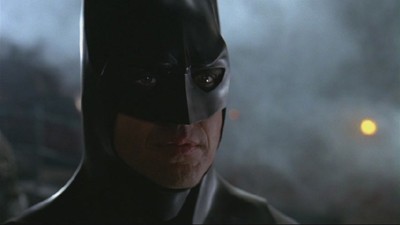 "Why are you now determined to prove that this Penguin is not what he seems? Must you be the only lonely man-beast in town?" -- Alfred, Batman Returns "Why are you now determined to prove that this Penguin is not what he seems? Must you be the only lonely man-beast in town?" -- Alfred, Batman Returns After the rampant box office success of the original Batman, there wasn't much doubt in anyone's mind that Burton and co. would be back for another summertime installment into the D.C. character's cinematic canon. They had a tough marker to reach though, as the original film clawed its way to earning back roughly seven times the amount that its production cost in domestic ticket sales. Even amid question, the darker Batman tone worked, both cinematically and with audiences -- so naturally, Edward Scissorhands director Tim Burton would press forward in a similar direction. Lo and behold, he would even upstage himself with the exceptional Batman Returns, even if ticket sales look like they prove otherwise. With fresh faces in production design and scriptwriting to its name, Batman Returns delivers a darker, meaner, and more intellectually fascinating film than its predecessor. It continues Burton's idea of the "moving comic" aesthetic, but he tightens the execution and infuses it with a thematic rhythm that allows for the characters to develop alongside the story, not the other way around. This time, Batman's (Michael Keaton) focal enemy is Oswald Cobblepot (Danny DeVito), a sewer-running circus escapee that was born disfigured in the image of a short, stocky man with flippers for hands -- earning him the nickname "penguin". He operates a network of criminals from under Gotham, largely in spite of his parents ditching him at a young age, all of which come together into a maniacal scheme to blackmail one of city's biggest financial figures, Max Schreck, to help him discover who his parents are. Or so it seems. Penned by Heathers' writer Daniel Waters, Batman Returns has much tighter grasp on cohesive storytelling and, to our enjoyment, a firmer hold on dialogue. Waters' presence can best be felt in the dialogue, as it blends indulgent speeches with more grounded, sharp-tongued rhetoric. Paired with Burton's understanding of the mistakes he made with the first picture, he improves upon his formula by wedging in Freudian slips for personality and a finely-tuned sense of immediacy with The Penguin limitless, animalistic urges. Batman Returns is largely a battle of snipping words and wits among the film's key players, and it's a fireworks show in that respect, but it's also an intriguing tightrope walk between vigilantism and villainy in Batman's character. Burton obviously keeps the villainous focus again, as he thrives in relishing in the brashly dark and demented with Batman lurking in the shadows. This time, however, their presence rings true as subconscious facets of Batman's personality, something only lightly touched on in Batman. Bob Kane's creation has always thrived on a psychological parallel between him and his enemies, showing that they share more in common than we'd oftentimes like. His connection with the Penguin is evidence of this, as we literally get the image of Danny DeVito's ugly, oozing orphan embodiment of a freak existing within Batman's psyche. DeVito does a fine job of brings the squawking abomination to life, giving him an oddly perverse sense of creepiness that never takes us away from his monstrous image. 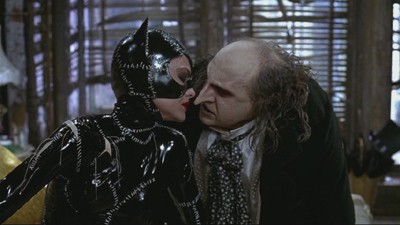 But here's where Returns gets really good. Alongside Penguin's story, however, it also focuses on the development of Selina Kyle (Michelle Pfeiffer), a stilted and somewhat shy secretary that transforms into the minx-y character Catwoman. It's in her presence that we see most of both Batman and Bruce Wayne, as the two of them build a comic-infused dynamic harping back to several plot lines throughout the books. Her genesis is superb, digging into the hero-villain identification even further as she intertwines with the Caped Crusader both near the fireplace and in the bleak shadows of Gotham City's alleyways. But here's where Returns gets really good. Alongside Penguin's story, however, it also focuses on the development of Selina Kyle (Michelle Pfeiffer), a stilted and somewhat shy secretary that transforms into the minx-y character Catwoman. It's in her presence that we see most of both Batman and Bruce Wayne, as the two of them build a comic-infused dynamic harping back to several plot lines throughout the books. Her genesis is superb, digging into the hero-villain identification even further as she intertwines with the Caped Crusader both near the fireplace and in the bleak shadows of Gotham City's alleyways. It ends up being the only real romantic angle that has actually worked in the Batman franchise, offering Bruce Wayne the only worthy "competitor" to his bizarre duality. It's interesting; though we haven't seen Batman's actual origin story up until this point, watching Selina Kyle crumble into her alter ego closely resembles the psychological turmoil likely endured by our hero in his angst with the world. Michelle Pfeiffer absolutely steals the show as Catwoman -- and even more so as Selina Kyle -- by giving us a haunted dual personality that only seems to exist due to society's cruelty. Cruelty, however, is both Batman Return's bane and its most alluring attribute. Burton found a way to blend desolation with a superhero's whim to create a dark yet audience-friendly style in Batman. His gloves are off here, which shows through the darker steps that he takes. Child abandonment, death, and an all-around sense of morbidity saturate Batman Returns, which takes it into protest-worthy territory for its morbidity. Though rash, it fits well with the growingly unstable Gotham City -- and aligns perfectly with the director's sinister style. Burton takes on a familiar name in Bo Welch for constructing Batman Returns' darker production design, one that carries over a similar feel to the collaboration's previous effort, Edward Scissorhands. It keeps the intrusive imagery of large statues towering over Gotham City -- taking a jab at signifying oppression underneath the city's skyscraper-laden horizon -- but it also signifies a scant sense of hope through the bright colors of Christmastime swirling around all of the icy blues and billowing blacks -- precursors to the visual motifs that would pop up in Burton's The Nightmare Before Christmas. Batman Returns, with all its mid-level psychoses, vibrant dialogue, and taut concentration on keeping the story flowing, can be a deeply unsettling yet gripping foray into the comic book genre that grows on viewers similarly to an evolving appreciation for music. At any given point, one style of rhythm and tone might not strike a chord, while another does for almost unexplainable reasons. This time, Burton's second Batman film resonated much more as a sprawling, complete experience over its art-heavy big brother. It's not one for the kids, but it's certainly one for the adults -- especially those that relish in the plagued grimness of the graphic novels that influence Tim Burton's efforts. He's not trying to mirror any particular one this time around, nor trying to completely replicate the narrative style of the comic book like he did with Batman. Instead, he's out to combine intriguing characters with the striking darkness of Gotham City in a grand scheme to create a bizarre, action-infused experience that speaks to the essence of the character. And it does, in droves. Click here for the Blu-ray A/V analysis on Batman Returns. Batman Forever (1995):  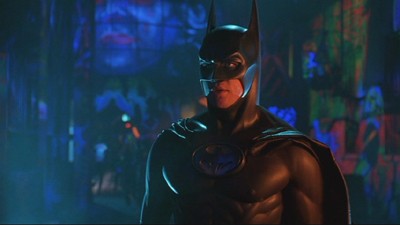 "It just raises too many questions." -- Bruce Wayne, Batman Forever "It just raises too many questions." -- Bruce Wayne, Batman Forever You bet it does, Mr. Wayne. Brass tacks, right? That's a big motivation behind the overhaul point in the '90s Batman films. After seeing a "decline" in box office earnings from a $30m to $250m spread with Batman to only doubling their production margin with $160m in ticket sales with Batman Returns, Warner Brothers decided to scoop the nocturnal character out of the darkness that bolstered the previous pictures into artful successes and plop him into a brighter, more vibrant Gotham for the third installment, Batman Forever. Burton wanted no part of directing a candy-coated Batman picture, and Keaton didn't succumb to the whims of high-dollar offers to reprise his role either. As a result, under the rigid hand of Falling Down director Joel Schumacher, a half-hearted Burton producing, and a slew of fresh Gothamite faces, Batman Forever is a drastically different telling of the Caped Crusader -- leaving it as little more than big, billowing silliness best suited for a warm summer afternoon without a thought in your mind. It follows Batman as he battles Harvey Two-Face Dent, an ex-District Attorney, and The Riddler, a psychotic Joker knock-off who previously worked as an engineer within Wayne Enterprises' science program. While struggling with two more villains hell-bent on destroying Gotham, Bruce Wayne also struggles with remembering elements of his past -- highlighted by flashback sequences -- and a budding relationship with psychologist Dr. Chase Meridian, a woman more fascinated with Batman's nature than settling down with a billionaire. On top of all that, we're introduced to Dick Grayson, aka Robin, after his family suffers a horrendous circus accident that leads him to fall under the care of Wayne manor. Schumacher takes roughly ten minutes to tear down all the substantial qualities that Tim Burton constructed in the previous two films, devolving the Batman franchise equally as much as Batman Returns took Batman forward. That, sadly, was the intent. Batman Forever replaces the gargoyle-covered brooding atmosphere and eeriness of character establishment with an acid-trip aesthetic that husks reality clean from its proceedings, seeming like a collage of the '60s Adam West style of Batman with a mishmash of Blade Runner-style neon stimulation and overzealous art deco design. Scathingly annoying lines of dialogue also crop all over the place, laying waste to any sort of one-liner efficiency crafted in the first two pictures. All that's missing is a "blam" and a "ka-pow" on-screen -- thought there just might be one or two of those tossed into the unpleasantly ornate backgrounds without our knowing. Batman Forever's biggest problem lies in physics, oddly enough. Actually, it's in Schumacher's starry-eyed grasp on reality in the image of nonsensical comic-book theatrics, but it mainly revolves around the disbelief constructed through all the loony things that he tries to pull off. In his world, everything occurs in a pitch-perfect fashion that somehow outdoes the ridiculousness achieved in the pages of a comic book. Each event in the picture is left with a glaring question -- "How could Batman size up that wire perfectly with the wall?", "Why does the Batmobile suddenly have hydraulics", and my personal favorite ... "How in the hell can a car ride up along the side of a building, and where on earth does it land?" -- questions that are never answered, yet expected to be swallowed down for entertainment's sake. Oddly, they're just crazy enough to accept in spats. 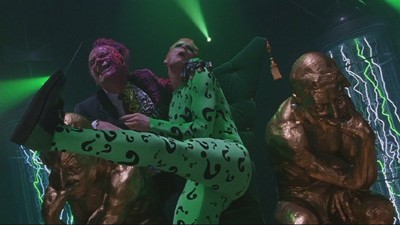 The only things that save Batman Forever from diving deeper into the pits of detest amid its headache-inducing garishness is the charisma from Jim Carrey -- an odd play on paradigms since he's causing all the raucous -- and a fine Bruce Wayne from Val Kilmer. Batman Forever falls right in the core of Jim Carrey's reign as a box office juggernaut, which shows through his stitched-together, over-caffeinated funneling of Lloyd Christmas and Ace Ventura into The Riddler. But that plays well for the character, even if it doesn't exactly challenge either Carrey or the audience. Though Tommy Lee Jones never really sells us on Two-Face, he and Carrey share a bizarre chemistry that still lights up the screen. The only things that save Batman Forever from diving deeper into the pits of detest amid its headache-inducing garishness is the charisma from Jim Carrey -- an odd play on paradigms since he's causing all the raucous -- and a fine Bruce Wayne from Val Kilmer. Batman Forever falls right in the core of Jim Carrey's reign as a box office juggernaut, which shows through his stitched-together, over-caffeinated funneling of Lloyd Christmas and Ace Ventura into The Riddler. But that plays well for the character, even if it doesn't exactly challenge either Carrey or the audience. Though Tommy Lee Jones never really sells us on Two-Face, he and Carrey share a bizarre chemistry that still lights up the screen. Kilmer, however, does something rather off-color that audiences weren't expecting; instead of playing up Batman, an arguably easier task since he's masked, he actually sells the pretty-boy billionaire with a dark secret extremely well. The scenes where Wayne dives into his past, oftentimes with the aptly-played Kidman as Dr. Meridian nearby, feel oddly out of place because they're successful in giving a little bit of depth in an overwhelmingly shallow film. His origin starts to lightly trickle into the picture, but gets harshly interrupted. This is due in large part to editing room antics, something that refers to an alternate cut of Batman Forever that was harsher in tone and more reflective on Wayne's genesis. To top it all off, you've got Robin. Schumacher's vision of Batman doesn't exist without Robin, which is a shame since solo Batman is far more intriguing. There's a reason as to why it took this long for Dick Grayson to make an appearance in the stories: it's because adult viewers just don't want the Boy Wonder, let alone a partner for Batman's psycho-analytical purging of crime from Gotham. He never found a comfortable entry point in either of Burton's pictures, but, hey, Schumacher's film is just outlandish enough to make it work. Chris O'Donnell does almost exactly what he does in Scent of a Woman and Fried Green Tomatoes, giving women something pretty to look at while staying just charming enough not to aggravate. He gives kids a figure that speaks to their desire to work with Batman, yet he just feels like a sloppy addition to the comic-minded. Forever can be troubling like this in a slew of obnoxious ways that take you clean out of the flick, one where you've got to pretend that Isaac Newton didn't even exist to appreciate its lunacy. For all intents and purposes, Batman has become vapid eye-candy in Schumacher's riff with nothing on its mind but shooting enough attractive material to splice together a good trailer (read: pitch) and sustain enough cinematic stamina to keep the ageless audience dumbfounded in bright colors and explosions. It's hit-and-miss in that respect, sometimes staying fun enough to satisfy the top layers of action-lover's enjoyment while others seeming too far out of reality's reach to even merit absorption. Batman Forever's a product, an almost opera-style saccharine performance, one that many suffer buyer's remorse for trying. It's a mess that had the potential to be a much better Batman movie in its original cut, but at least the final product is a brassy, exciting one. Click here for the Blu-ray A/V analysis on Batman Forever. Batman and Robin (1997):  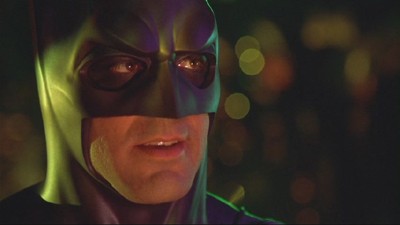 "Mercy? I'm afraid my condition has left me cold to your pleas of mercy." -- Mr. Freeze, Batmand and Robin "Mercy? I'm afraid my condition has left me cold to your pleas of mercy." -- Mr. Freeze, Batmand and Robin Sure, it's "all too easy" in ole' Darth Vader's words to pick on Schumacher's second foray into the Batman universe, Batman and Robin. Over the years, Batman and Robin has turned into quite the punching bag for movie lovers, critics, and comic book aficionados alike. But it's no surprise that this has happened, nor is it undeserving; in the first eight minutes, we have Batman skating along the back of a brontosaurus, Robin exploding through a wall while leaving his bird symbol as the hole behind him, and no less than five one-liners from Mr. Freeze about ice, freeze, frost, chilling, and all sorts of other frozen stuff. Somehow, this is technically in the same universe as Burton's lurid bleakness and Nolan's taut humanism, believe it nor not. But even in comparison, Batman Forever is a pragmatic work of art compared to the mind-numbing and, oftentimes, insulting assonance of Schumacher's sequel. Yes, it's really that dreadful. Batman and Robin puts a lid on Warner Brothers' empire of films by taking many, many wrong turns in telling this story. It zeroes in on the dynamic duo engaging Mr. Freeze, a one-brilliant scientist who now spends his days hunting down diamonds to fuel the cryogenic suit that keeps him alive. But he's got an underlying motive; he must also use these diamonds to develop a technology that'll cure his wife's advanced case of McGregor's syndrome, a condition that has left her suspended in a catatonic state. He finds a villainous match with Poison Ivy, a renegade scientist herself who uses her aromatic allure to enchant men into doing her bidding. If those two weren't enough, Ivy's also lugging around a beefy, mindless minion -- none other than Bane, a far cry from his intelligent comic book counterpart. Schwarzenegger and Thurman didn't even have a chance at cracking into the audience with their villainous personas. All of their dialogue is specifically constructed to craft Mr. Freeze into a walking punchline, with Poison Ivy scurrying right behind him with an array of leafy lines to match his ice-based stupidity. Sadly, it's entertaining to watch for all the wrong reasons, building their dynamic into a laughably bad duo that almost seems ready to break out into a chorus line. Oddly, they're also two of only a handful of Batman's "magic wielding" enemies, an embarrassing combination that results in a pair of dodos that build little core interest and no threat. But they sure are pretty and marketable -- I believe "toyetic" is the word. 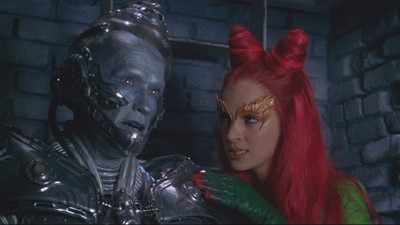 It's beyond me how Schumacher could transform a comic book movie with the Terminator, The Bride, and Danny Ocean all playing superhero characters into such a ghastly conglomeration of tedium and headache-inducing aesthetic torture -- but he does. Close to nothing goes right in Batman and Robin, as it twists and turns around a vapid script containing profuse one-liners and comic-book backstabbing. It spices up the narrative with plot kinks such as having a manly Robin warring with Batman over Poison Ivy, along with Alfred's chirpy little niece rolling into town only to reveal that she's a motorcycle-riding, ass-kicking computer geek. Batman had been bitten by the Saturday morning cartoon bug, and the result is artificiality at its most feeble. It's beyond me how Schumacher could transform a comic book movie with the Terminator, The Bride, and Danny Ocean all playing superhero characters into such a ghastly conglomeration of tedium and headache-inducing aesthetic torture -- but he does. Close to nothing goes right in Batman and Robin, as it twists and turns around a vapid script containing profuse one-liners and comic-book backstabbing. It spices up the narrative with plot kinks such as having a manly Robin warring with Batman over Poison Ivy, along with Alfred's chirpy little niece rolling into town only to reveal that she's a motorcycle-riding, ass-kicking computer geek. Batman had been bitten by the Saturday morning cartoon bug, and the result is artificiality at its most feeble. Speaking of Penny, there's also the entire family angle of Batman and Robin -- something that feels straight out of an after-school special jammed into a teenager-friendly environment. In it, the dynamic duo bickers among themselves like a pair of brothers fighting over the attention of their parents. Their "parents" happen to be the media and citizens of Gotham City, the very people that they're trying to protect. It's pretty absurd to see Dick Grayson fighting so hard to wedge underneath the tutelage of Batman in Forever, and then see him turn around the next minute into a spotlight-hungry brat. All of this revolves around the fact that Alfred's health is rapidly depleting, which continuously brings up the fact that he won't be around forever to take care of the two superheroes. We care for Alfred -- how can we not, since he's the only other actor that's stuck around the films outside of Pat Hingle as Commissioner Gordon -- but there's a distinct gushiness about it that just feel unnatural. Why Warner Brothers and Joel Schumacher thought some of these off-kilter deviations were wise ideas is beyond me. Hell, let's take a fiscal outlook on this: where, anywhere, would it seem like a good investment to have Batman whip out a credit card with his name and logo on it? That's not even considering the implications behind the credit card -- did Wayne or Alfred set up the bank account, could it be traced, is it a joint account with Bruce Wayne, etc. -- but the sheer silliness of the card, let alone the cornball "never leave the cave without it" line, just drives anyone with half a mind far away from even wanting to enjoy the camp value. I get that it's an ode to the '60s West style of Batman, a demeanor marked with Shark Repellent and Anti-Penguin pills, but at least those were clever and not without some form of explanation. It takes a lot for Bayman Forever to seem somehow realistic, but Batman and Robin accomplish that not-so-proud feat by cloning its predecessor and strategically designing its mise-en-scene around profit instead of potency. With a different director, visual aesthetic and non-hackneyed script overflowing with horrible one-liners, something might've come out of the Schwarzenegger / Thurman villainous team -- as well as out of Clooney as the Caped Crusader. But with each ghastly ornate set design and nipple-suited battle of one-liners and spastically-edited fight sequences, the whole of Batman and Robin's $100+ budget does nothing but freeze the film's momentum in its tracks. Where Forever was vibrant, boisterous silliness molded by marketing suits and pop-art mannerisms into a product to chomp up and forget, Batman and Robin literally becomes a feeble imitation to inspire age-sprawling consumption -- and the triteness is almost impossible to bear. Since then, Warner Brothers has more than redeemed itself with an outstanding reboot that comes close to flushing Batman and Robin clear from our memory ... almost. Click here for the Blu-ray A/V analysis on Batman and Robin. The Blu-ray:
Presented in a layered box system that will seem very familiar to those who purchased the standard-definition Motion Picture Anthology, the Batman: Blu-ray Anthology will certainly shock with its size constraints. Each film is presented in its own ultra-slim Blu-ray case, making this package quite the space saver. For a tangible size comparison, it's roughly the thickness of two standard-Blu-ray cases -- or almost exactly the total width of the Close Encounters of the Third Kind Blu-ray set. Note: Only one of the Blu-rays is a two-disc set -- the original '89 Batman. The second is a standard digital copy disc, with label art resembling all of their other digital copies that WB has included with their releases. Video and Audio: As you can expect, high definition quality varies greatly from film to film in the Batman franchise. All of them are presented in extremely strong 1080p VC-1 encodes, framed a little higher at 1.78:1 to fill the screen from top to bottom just like their standard-definition counterparts, and are matched with English Dolby TrueHD tracks. Each one also has a Dolby Digital 5.1 track, as well as the following language options: French, German, Italian, Spanish, and Portuguese, with Subtitles are available in optional English, French, German, Italian, Spanish, Dutch, Chinese, Korean, Portuguese, Danish, Finnish, Norwegian, and Swedish languages. Though I can't confirm the fact, it's reasonable to assume that Warner's Batman Blu-ray Anthology is region-free since it has all of those subtitle options. After careful looking to and from the two discs for the original '89 Batman, it's reasonable to assume that the U.S. and U.K Blu-rays are identical, if minimally different in compression -- something that likely carries over to the rest of the set. In general, they're all a knockout for their own reasons, yet they fluctuate in excellence from film to film: Batman: 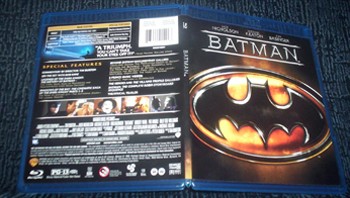 Batman's image, being the oldest, shows the weakest image quality out of the four pictures. However, to call this the "weakest" isn't that harsh of a critique, as the visual quality can be stunning at times. A fine level of film grain drapes over the image, never seeming too heavy or obtrusive on the film experience. Contrast, as to be expected, is the most important thing to consider in the dark, dreary picture, which is handled with inky blacks and solid mid-range shadows. Colorful scenes, however, also look extremely good; elements like the wood grain and mossy plants in Bruce Wayne's mansion are all properly saturated, while the lighting and minutiae inside the Gotham Gazette's intricate, pedestrian atmosphere look fantastic. Even production elements, like the textures of The Joker's make-up and the contours of the Batplane, show a significant level of texture, while the range of moment always stays strong and free of warping. Batman's image, being the oldest, shows the weakest image quality out of the four pictures. However, to call this the "weakest" isn't that harsh of a critique, as the visual quality can be stunning at times. A fine level of film grain drapes over the image, never seeming too heavy or obtrusive on the film experience. Contrast, as to be expected, is the most important thing to consider in the dark, dreary picture, which is handled with inky blacks and solid mid-range shadows. Colorful scenes, however, also look extremely good; elements like the wood grain and mossy plants in Bruce Wayne's mansion are all properly saturated, while the lighting and minutiae inside the Gotham Gazette's intricate, pedestrian atmosphere look fantastic. Even production elements, like the textures of The Joker's make-up and the contours of the Batplane, show a significant level of texture, while the range of moment always stays strong and free of warping. Little details jump out at you frequently in this image, like the paisley on Bruce Wayne's scarf and the wild shimmering sheen in The Joker's clothing as he sitting with Vicki Vale at a dinner table. It probably has something to do with my fondness of the scene, but the entirely of that Art Museum sequence looks fantastic -- from the dripping green paint on the statue to the marble grain within the floor. At times, you might think that the image seems altogether desaturated, but then you'll see a blast of color from The Joker's garb and it'll take you aback with its vividness. There are one or two spots where skin tone gets just a bit pinker than others (especially at the beginning with the two strung-out thieves) and others where it gets mildly pale, but these instances are exceedingly negligible. Most importantly, Batman preserves every ounce of texture present in the image, showcasing little digital manipulation or edge enhancement. This Blu-ray transfer almost makes the film look like it was shot on the set much earlier than its age, which is one of the best testaments to Warner Brothers' image that you can give it. As for the audio treatment, Batman's neither an attractive sounding film nor terribly dynamic when shifted from its 2.0 mix to 5.1. Elfman is on record as stating that he's unhappy with the way the film's mixing played out in the theaters, something that has hardly improved in the home video format. With that said, Batman's TrueHD track sound about as good as the sound design possibly can, though there's a high pitch that crops up in a few spots (once again, the art museum scene). Gunshots are muffled and explosions are suppressed, while the score ranges in audibility all throughout the picture. However, this high-quality treatment of the low-grade materials gives the audible elements a noticeable lift in clarity and sharpness, something definitely noticeable in verbal transparency. Elfman's score, interesting enough, sounds surprisingly robust this time through, even if it pushes a little harder over the remainder of the track. However, it's certainly a boost up from the decent DTS presentation on the standard-definition package, though it's not exactly a showcase for the new class of audio formats. Batman Returns: 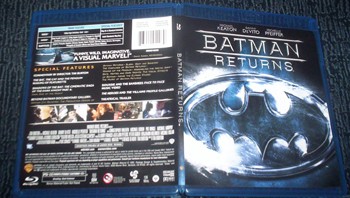 Burton's second film boasts my preferred transfer out of them all, even if it's not unequivocally the best. Batman Returns holds many of the same visual properties of the original Batman in regards to light grain and lack of manipulation, but the vividness showcases a higher grade of film stock and stronger concentration on color brilliance. It really shows in this high-definition image, making the first film's excellent transfer pale in comparison. Leaps in image strength can be seen in the first moments of the film, evident in the rich detail within the Christmas tree, the wood grain in the flooring, and the stark detail in the prop elements in the background of the cage. Taking place during Christmas, Returns formulates a unique image that mixes bright greens and reds with blistering lights that intertwine with the dark, deep blacks and grays that drape Gotham City. Darker and inkier blacks and even more solid shadowy details twist around the bright splashes of color -- all of which stay solid without blooming or showing compression issues. Burton's second film boasts my preferred transfer out of them all, even if it's not unequivocally the best. Batman Returns holds many of the same visual properties of the original Batman in regards to light grain and lack of manipulation, but the vividness showcases a higher grade of film stock and stronger concentration on color brilliance. It really shows in this high-definition image, making the first film's excellent transfer pale in comparison. Leaps in image strength can be seen in the first moments of the film, evident in the rich detail within the Christmas tree, the wood grain in the flooring, and the stark detail in the prop elements in the background of the cage. Taking place during Christmas, Returns formulates a unique image that mixes bright greens and reds with blistering lights that intertwine with the dark, deep blacks and grays that drape Gotham City. Darker and inkier blacks and even more solid shadowy details twist around the bright splashes of color -- all of which stay solid without blooming or showing compression issues. But Batman Returns does more than aptly represent the material like its predecessor -- it really pops in quite a few scenes. Essentially, that encompasses every single scene with Michelle Pfeiffer in cat garb, and not because of the woman's allure. Her costume, glistening in the light and haphazardly stitched together from faux leather, showcases how strong light rendering and minute detail can look in high-definition. It's even more impressive when she's got Batman next to her, as the lighting also bounces off of his more matte textures in a different sort of glimmer. Some of the more surprisingly vivid scenes, however, occur in the penguin's lair with the oddly-colored water and the penguin's nasty swill trickling from his "beak". Adding to the complexity even more, the fluctuating shades of pink in Selina's apartment also show the disc's capacity to handle a range of somewhat muted tones. Maybe it's because the film resonated more with me this time than most, but Batman Return's transfer gets my pick of the litter from the set. Easily a step above Batman in the audio department, Returns really showcases the fact that it's the first film composed with a Dolby Digital 5.1 mix. It sports a rich competency in verbal clarity, something surprisingly important in this addition to the canon. A few explosions pop up in spots that sound great, as well as a few gunshots that ring true (though a little hollow in the lower frequencies), but the more resonant elements of the track are the punches and thuds that rattle the speakers during hand-to-hand combat. There's also the crisp cracking of Catwoman's whip, something that shows off the dimensionality of the track rather well. Elfman's score sounds fantastic this time around, balancing well with the verbal clarity and sound effects. It's not quite as big of a jump from the DTS track as Batman was, but the additional clarity in higher elements and the extremely well-pitched vocal clarity make this TrueHD track a strong accompaniment for a beautiful image. Batman Forever: 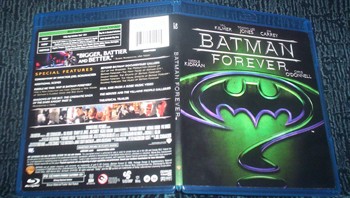 It's hard to cherry pick between Returns and Forever for the marker of best image in the set, because Batman Forever looks exceptional for a slew of distinctive reasons. Since there's a whole different world of color in its neon set design, swirling lights, and hyper-saturated visuals, there are a lot more opportunities to showcase exactly what this Blu-ray disc can do. Stephen Goldblatt's unique, swirling visual design relies on a lot of quirky comic-style mannerisms, all of which absorb minute details in the environment -- like the architectural eccentricities in Dr. Meridian's office and the rotund claustrophobia of the circus, and the -- into a surprisingly three-dimensional experience. Goldblatt is also a big success in close-ups and multi-actor shots (also seen in his work in Charlie Wilson's War), something that echoes firmly in the image through robust skin tones and sharp textures. It's hard to cherry pick between Returns and Forever for the marker of best image in the set, because Batman Forever looks exceptional for a slew of distinctive reasons. Since there's a whole different world of color in its neon set design, swirling lights, and hyper-saturated visuals, there are a lot more opportunities to showcase exactly what this Blu-ray disc can do. Stephen Goldblatt's unique, swirling visual design relies on a lot of quirky comic-style mannerisms, all of which absorb minute details in the environment -- like the architectural eccentricities in Dr. Meridian's office and the rotund claustrophobia of the circus, and the -- into a surprisingly three-dimensional experience. Goldblatt is also a big success in close-ups and multi-actor shots (also seen in his work in Charlie Wilson's War), something that echoes firmly in the image through robust skin tones and sharp textures. Then, there's the ridiculous usage of blistering color throughout Batman Forever, an element that takes this Blu-ray disc in the realm of demo-worthy material. Whether we're talking about Two-Face's gothic-inspired lair or the neon shades dancing around in Gotham's indigo alleyways at night, it typically stays healthy without pushing beyond its limits in contrast -- though a few scenes do seem a bit bloated in the saturation levels. There's a bountiful level of grain that, at times, gets a little harder to discern between film grain and compression issues in the darker Batcave sequences, but it generally stays rather true and filmic during brightly-lit and outdoor sequences. It's manipulation free and seeming clear of edge enhancement, which builds Batman Forever into an fluid visual rendering of a wildly aesthetic film. Batman Forever, however, slightly edges over Returns in audio quality. Since this track is a few years younger, it sports a noticeably crisper verbal clarity than the other. Audio is never inaudible, though it does push a little hard at the upper quadrants -- giving one or two louder verbal scenes a little bit of a rasp. Everything else, however, is boisterous, tight, and absolutely brilliant to the ears. Sound effects like the ringing of Two-Face's coin and the sound of Edward Nygma's box working its magic stretches to the higher points of the TrueHD track with no problem. Plenty of effects activate the lower-frequency channel as well, like a myriad of explosions and artificial elements in the zany sound design. It also makes ample usage of the surround design, stretching elements like the Batmobile's movement to the rear channels. Moreover, Elliot Goldenthal's quirky Elfman-replacement score sounds exceedingly good as a backdrop the blend of robust action elements and subtle conversation scenes between Kilmer and Kidman. It's a great audio track, one that's bold in all the right places and subdued in all the rest. Batman and Robin: 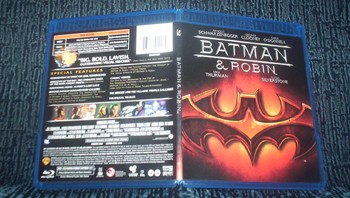 Surprisingly, Batman and Robin isn't all that impressive for being the latest of the Batman films. As to be expected, there are several moments where the high-definition transfer looks excellent; Schwarzenegger's make-up consistently looks outstanding, as do the heavy-as-hell costumes that Clooney and O'Donnell lug around from scene to scene. Poison Ivy's make-up and costume design also look smashing, showcasing the ornate, "organic" glitz that bring her posh demeanor together. Even more so than Forever, Batman and Robin utilizes a ridiculous cornucopia of colors, especially neon shades. They all behave themselves quite nicely, staying within their boundaries without blooming to overzealous levels at any point. This becomes clear during the jungle party sequence where, I swear, you'd probably be able to pull out all 16 million+ color possibilities. Surprisingly, Batman and Robin isn't all that impressive for being the latest of the Batman films. As to be expected, there are several moments where the high-definition transfer looks excellent; Schwarzenegger's make-up consistently looks outstanding, as do the heavy-as-hell costumes that Clooney and O'Donnell lug around from scene to scene. Poison Ivy's make-up and costume design also look smashing, showcasing the ornate, "organic" glitz that bring her posh demeanor together. Even more so than Forever, Batman and Robin utilizes a ridiculous cornucopia of colors, especially neon shades. They all behave themselves quite nicely, staying within their boundaries without blooming to overzealous levels at any point. This becomes clear during the jungle party sequence where, I swear, you'd probably be able to pull out all 16 million+ color possibilities. However, there's a softness that arise in a few places that rival a few issues with the first film's clarity -- even a little bit worse. Several portions during Ivy's dance soften up a little bit, though they never grow digitally pixelated. Furthermore, many sequences showcase a fair amount of grain in more densely-detailed portions, noticeably outside of Freeze's hideout and during the "hockey team from hell" sequence. Black levels are hit and miss; they can be deep at times -- about on par with Forever, hiccups and all -- with overall contrast strength, but there's also quite a few scenes where the black levels take on a greenish shade. To make up for it, there are quite a few densely-detailed scenes, like the Amazonian sequences with Pamela Isley and several party sequences, that grab a hold of every detail in the frame and scream with clarity enough to mask imperfections. It's a very good image, but it's not quite the stunner that I'd expect it to be. Here I was expecting the worst film in the set to be the radiant demo disc, whereas I'd probably use the second-oldest for texture and intrigue's sake. Batman and Robin's sound design is rather wonky as well, providing a crisp, clean yet discomforting sound design. There's something about the boldness of the re-recorded vocals (ADR) that sounds out of place across the track, something that sounded off in the DTS track and now pops out much more with the added clarity of TrueHD. Of course, outside of that Batman and Robin glistens with the commonplace aural polish of any mid-'90s blockbuster. Crashes of ice rattle the speakers with intense crispness, car crashes blast into the lower-frequency channel, and the "swooping" sound of the gang's series of grapple hooks send a mid-range effect across the soundstage that delivers quite a punch. Batman and Robin sounds great, even though it also reveals the elements that the sound design wishes to hide by adding crispness. Special Features: Quick and Dirty Answer for Anthology Veterans: All Features from the 2005 standard-definition Motion Picture Anthology have been carried over -- no more, no less. All of them are presented in VC-1 encoded standard-definition concoctions that look lackluster (aside from a few exceptions). 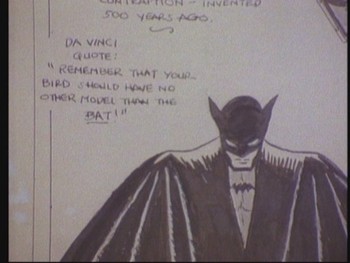 For Batman, we're first treated to a Director's Commentary from Tim Burton. Though sparse in frequency, his brain really wraps around the stuff that he talks about throughout the track. Next, we've got an On The Set with Bob Kane (2:33) marketing-style featurette that focuses on Bob Kane's trip through memory lane while he's at Pinewood Studios. Following that, a History of Batman (40:30) featurette discusses the origin, conception, and longevity of the character. Interview time is spent with several of the artists that have drawn Batman over the years (Frank Miller, Mike Mignola, etc.) as well as other "experts" as we learn all about Batman's literary journey, a history deeply connected to comic's relationship with wartime and personal connection with its readers. For Batman, we're first treated to a Director's Commentary from Tim Burton. Though sparse in frequency, his brain really wraps around the stuff that he talks about throughout the track. Next, we've got an On The Set with Bob Kane (2:33) marketing-style featurette that focuses on Bob Kane's trip through memory lane while he's at Pinewood Studios. Following that, a History of Batman (40:30) featurette discusses the origin, conception, and longevity of the character. Interview time is spent with several of the artists that have drawn Batman over the years (Frank Miller, Mike Mignola, etc.) as well as other "experts" as we learn all about Batman's literary journey, a history deeply connected to comic's relationship with wartime and personal connection with its readers. The Road to Gotham (17:45) operates as general marketing fluff delving into the conception of the picture, splicing together footage from the film with interview footage. However, there's some really great archive footage at play that makes it highly intriguing to watch. Gathering the Storm (22:59), though similar in design to the previous featurette, is an exceptionally intriguing featurette that closes in on the difficulties in scripting Batman. They realize that it was a bumpy road to get to the final product, which is all chronicled here with some really great behind-the-scenes still shots intermingled within. There's some great quips inside, including the reason why Robin's not in the film, focus on Keaton's casting, and what portions of the script belong to which of the many scriptwriters. The Legend Reborn (30:59) works as an answer to the fan critism that largely spurned the production of the picture, a dense featurette that covers how they could create the picture-perfect Batman film on as low of a budget as possible, marketing and all. Once again, more fascinating archive footage highlights this featurette, while input from Jack Nicholson and Sam Hamm contribute some really intriguing elements. Beyond Batman segments into six distinct production featurettes: Visualizing Gotham, Building the Batmobile, Those Wonderful Toys, Designing the Batsuit, From Jack to the Joker, and Nocturnal Overtures: The Music of Batman. Each lasts around ten minutes and follows a similar editing rhythm and style as the rest of the featurettes. Also included are a slew of character analyses on The Heroes and The Villains of Batman, a Theatrical Trailer (SD Anamorphic), and a series of Music Videos. Finally, we've got the full Robin Storyboard Sequence (4:24) that shows how Robin was originally drawn into the picture. 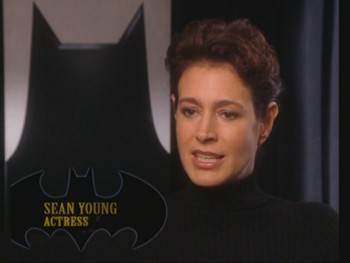 For Batman Returns, we've got another Director's Commentary with Tim Butron. He's a little more lively this time around, but he keeps his down-to-earth rhythm and easily accessible tone throughout the track. After the track, there's another general marketing-style featurette entitled The Bat, The Cat, and the Penguin (22:30) that mirrors the first twenty-minute featurette on Batman. For Batman Returns, we've got another Director's Commentary with Tim Butron. He's a little more lively this time around, but he keeps his down-to-earth rhythm and easily accessible tone throughout the track. After the track, there's another general marketing-style featurette entitled The Bat, The Cat, and the Penguin (22:30) that mirrors the first twenty-minute featurette on Batman. Next, we're taken through Shadows of the Bat, Pt. 4 (30:19), a fluid and intriguing featurette that finds Burton and his cast diving into the process of crafting the sequel. It focuses on Burton's reservation to get back into Gotham City, his intrigue with the villains, and the studio's alluring offer to make Returns a "Burton" film instead of a core Batman film -- and their new-enthusiastic desire to bring Keaton back as Batman/Bruce Wayne. Along with that, casting Penguin and Catwoman also comes into the picture, including Annette Benning's original casting as Catwoman and Sean Young's aggressiveness to try and snatch the role. Again, we've got the Beyond Batman series of featurettes, segmented as such: Gotham City Revisited, Sleep Sexy and Sinister (Custumes), Making-up the Penguin, Assembling the Arctic Army, Bats, Mattes, and Darn Nights, and Inside the Elfman Studio, each of which lasts around or just over ten minutes. Along with those, we've got a Music Video, character profiles for the Heroes and Villains from the film, and a Theatrical Trailer (SD Anamorphic). 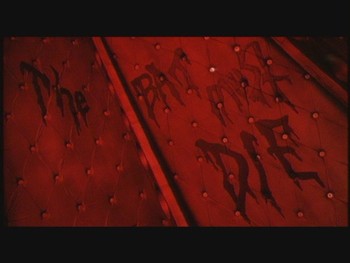 For Batman Forever, Joel Schumacher takes the chair for a Director's Commentary. He's lively and expository on the content, reflecting on the internal conflicts in the picture and focusing largely on the story instead of a heavy concentration of Film 101 style -- except for set design, which he always focuses on profusely. Continuing the theme of a twenty-minute marketing featurette being the first thing available, we've got Riddle Me This: Why is Batman Forever (23:25), a standard piece that contains a wealth of great behind-the-scenes shots. It's segmented by little "commercial breaks" into the individual characters. For Batman Forever, Joel Schumacher takes the chair for a Director's Commentary. He's lively and expository on the content, reflecting on the internal conflicts in the picture and focusing largely on the story instead of a heavy concentration of Film 101 style -- except for set design, which he always focuses on profusely. Continuing the theme of a twenty-minute marketing featurette being the first thing available, we've got Riddle Me This: Why is Batman Forever (23:25), a standard piece that contains a wealth of great behind-the-scenes shots. It's segmented by little "commercial breaks" into the individual characters. Also carrying over from the other discs is Shadow of the Bat, Part 5 (28:29), a deep slice of behind-the-scenes material that dives into making the "wild summertime blockbuster", or as Val Kilmer puts it, an "adult fantasy". It discusses the way that they captured the '50s comic strip feel instead of the dark Burton-esque tones, quickly -- and seemingly easily -- casting the picture, and Carrey's improvisational presence. It also covers the cut material that would've given Batman Forever a darker tone. Continuing with the production elements, we've got the Beyond Batman series of ten-minute featurettes once again, segment into: Out of the Shadows (Production Design), The Many Faces of Gotham City (Costume/Make-up), Knight Movies (Stunts), Imaging Forever (Visual Effects), and Scoring Forever. To round everything else up, we've got the Hero/Villain profiles, a Theatrical Trailer (SD Anamorphic), and a Music Video (Seal's Kiss from a Rose). However, the biggest and most intriguing element is an arrangement of score-less Deleted Scenes (13:58) that would drastically changed the film's tone, including the now-famous "dark opening" featuring Two-Face's escape from Arkham Asylum and the strong origin narrative involving the notebook. 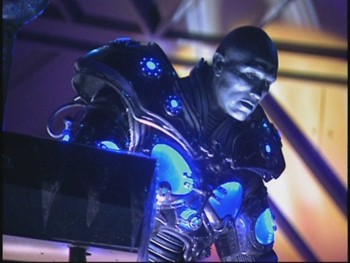 For Batman and Robin, Joel Schumacher gives us a Director's Commentary that dives into the filmmaking aspercts of the picture -- as well as taking a very apologetic tone. Schumacher takes an exceedingly lackadaisical tone that culminates to a hilarious point near the center of the track (53:00 and onward). Part 6 of the Shadow of the Bat (27:00) takes another thoroughly extensive featurette that concentrates on dissecting the "toyetic" nature of Batman and Robin. It's largely apologetic from all parties interviewed and, interesting, somewhat hostile among all the business-minded individuals. It focuses on Clooney's casting over the Saint-driven Kilmer, concentrating on being family-friendly, and diving into the extensive bizarreness of the "nippular" costumes. The best thing about this featurette is that they all know that Batman and Robin stinks, and they al revolve around that tone instead of flubbing the truth. Of course, it's become legendary for Schumacher's apology around the 23-24 minute mark. For Batman and Robin, Joel Schumacher gives us a Director's Commentary that dives into the filmmaking aspercts of the picture -- as well as taking a very apologetic tone. Schumacher takes an exceedingly lackadaisical tone that culminates to a hilarious point near the center of the track (53:00 and onward). Part 6 of the Shadow of the Bat (27:00) takes another thoroughly extensive featurette that concentrates on dissecting the "toyetic" nature of Batman and Robin. It's largely apologetic from all parties interviewed and, interesting, somewhat hostile among all the business-minded individuals. It focuses on Clooney's casting over the Saint-driven Kilmer, concentrating on being family-friendly, and diving into the extensive bizarreness of the "nippular" costumes. The best thing about this featurette is that they all know that Batman and Robin stinks, and they al revolve around that tone instead of flubbing the truth. Of course, it's become legendary for Schumacher's apology around the 23-24 minute mark. The Beyond Batman segment makes a return, this time encompassing: Bigger, Bolder Brighter (Production Design), Maximum Overdrive (Vehicles), Obsessed to Thrill (Costumes), Frozen Freaks and Femme Fatales (Make-up), and Freeze Frame (Visual Effects). Alsi included are the Character Hero/Villain bios, a series of Music Videos from the Smashing Pumpkins and Jewel, a Deleted Scene involving Alfred, and a Theatrical Trailer (SD Anamorphic) Final Thoughts: Batman has developed a lengthy lineage in the cinematic world. From the grotesqueries of Tim Burton's mind to the performance-geated Schumacher productions, they're a diverse class of entities as unique as the times that they take place in. Now, in the reign of Christopher Nolan's masterful Batman pictures, do they hold up? Two do, two don't. It all boils down to this: Batman and Batman Returns are two very artful, thematically rich and gripping renditions of the Dark Knight, while Batman Forever only satisfies on a surface-level, make-your-eyes-bleed kind of way -- and Batman and Robin to an even lesser degree. They're all entertaining on some very mild level, though Burton's pictures are the only two that'll provide enough thought to match up with the modern-minded Batman aficionados. Schumacher's riffs on the series claim to hark back to the '50s and '60s comics while paying homage to the Adam West television show, which you can take as a reasonable explanation or not for their boisterous, obnoxious kid-geared demeanor. Overall, I'd still recommend the whole-shebang as a slate of interesting achievements in production design, action choreography, and cinematography across the board, giving Burton's pictures exceedingly high marks while relegating Schumacher's pictures to rent-worthy diversions, the latter being one perfect for rifftracking with friends. 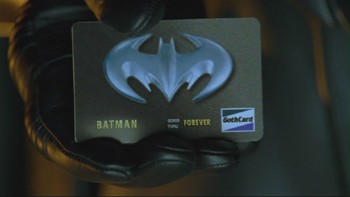 But we're not talking about a rental, or even a separate purchase at this point. There's a sole Batman: Twentieth Anniversary Blu-ray hitting stores in May, one that'll likely be this exact same disc as the one in this set and the UK Blu-ray. If that's the only one that you know you'll revisit, then by all means hold off on the set. However, Batman Returns becomes a tricky one to deal with, since it doesn't have an individual release slated anytime soon. I'll claim to favoring it this time around with the Batman pictures, holding much more thematic weight than I recall from my visit to it several years ago. There is, of course, a UK Import Blu-ray of Batman Returns available at Amazon.com and Amazon.co.uk. But we're not talking about a rental, or even a separate purchase at this point. There's a sole Batman: Twentieth Anniversary Blu-ray hitting stores in May, one that'll likely be this exact same disc as the one in this set and the UK Blu-ray. If that's the only one that you know you'll revisit, then by all means hold off on the set. However, Batman Returns becomes a tricky one to deal with, since it doesn't have an individual release slated anytime soon. I'll claim to favoring it this time around with the Batman pictures, holding much more thematic weight than I recall from my visit to it several years ago. There is, of course, a UK Import Blu-ray of Batman Returns available at Amazon.com and Amazon.co.uk. Speaking on quality alone without price necessarily in mind, The Batman Blu-ray Anthology comes with a firm Recommendation based on the strong visual and aural qualities matching the complete carry-over of the standard-definition box's slate of supplements. However, tread softly through bargain world while hunting down this set, as the high price tag is certainly a deterrent. As a Batman lover (in case you couldn't tell by the length of this article), it's certainly a blast to see all of these pictures presented in beautifully-rendered visual transfers and sounding nearly as good as they did in the theaters -- even if they now play second banana (or third, or fourth) to the new breed of Batman movie. Note: Screenshots in this review are taken from the first-print, standard-definition Anthology boxset and do not reflect the quality of the Blu-ray transfers themselves. |
|
| Popular Reviews |
| Sponsored Links |
|
|
| Sponsored Links |
|
|
| Release List | Reviews | Shop | Newsletter | Forum | DVD Giveaways | Blu-Ray | Advertise |
|
Copyright 2024 DVDTalk.com All Rights Reserved. Legal Info, Privacy Policy, Terms of Use,
Manage Preferences,
Your Privacy Choices | |||||||














